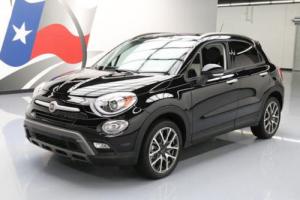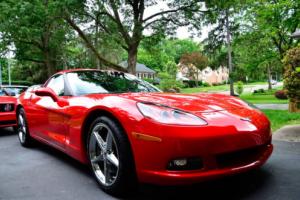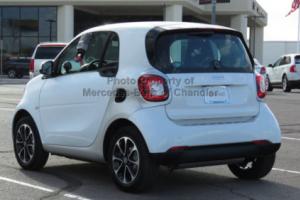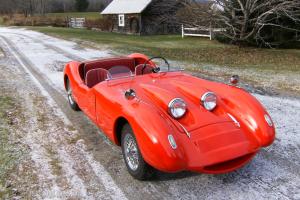Classic Cars / / Car for sale
Unique 1958 Westland Empire Aristrocrat Prototype. Fully Restored 1958
Sale price: $30,000.00 make an offer
Car location: Monroe, New Hampshire, United States
Sale type: Fixed price listing
Technical specifications, photos and description:
- Year:
- 1958
- Mileage:
- 18,787
- Engine:
- 948cc
- Got questions?
- Ask here!
Unique 1958 Westland Empire Aristrocrat Prototype. Fully Restored 1958 for sale
Current customer rating:1958 Westland Empire Aristocrat Prototype
Unique one-off prototype British sports car offered for sale. The car has had a complete ground up restoration and has won the Chairman's Award at several British Car Shows.
I am listing this car for a friend; please send me any questions and I will forward them to the seller for answers. What follows is a portion of the restoration history of the car. I will be happy to forward a complete pdf of a bound booklet put together by the seller to seriously interested parties; please send me your email address via eBay's messaging system.
There is a trailer available that was custom made for this car. with extra length and a fairing on the front. It will be available to the purchaser of the car for an additional $1000. (it appears in several of the photos) The seller will work with the buyer regarding shipping arrangements. The car is currently in Monroe. NH (not CT where the lister is) and the buyer will deal directly with the seller to complete the transaction.
The photos are all recent (except for the B&W from 1958!) but the date function on the camera was not set when they were taken.
The engine is a Morris Minor. 948cc. Four speed "smoothy" transmission. Clear title. Indicated mileage is 18787 but whether or not that is correct is unknown. as the car has been completely rebuilt it isn't all that important. either.
The 1958 Westland Empire Aristocrat Prototype
HISTORY
Richard and Barbara S.
Monroe. NH
Chapter 1. As Found!
We saw this car off and on from 1977 to 1981 in various open sheds or fully exposed to the weather. In 1981 it was put into covered storage and not again attended until 2003 when the restoration began. The initial inventory of parts and condition found no engine or engine parts except for a box containing a Morris valve cover. starter motor. heavily modified carb manifolds. coil. generator. and SU carbs. There was little wiring and the wooden dashboard and door post spacers were rotted and broken. All instruments were intact and mounted. The windscreen was without glass or posts. The upholstery had been red both for carpets and door/dash coverings. Side curtains were mostly intact. Most undercarriage materials were completely rotted away. Door latches and all mechanisms had been removed and were missing. Post receivers in the rear body had only parts of a drop-head frame and no covering. No front seats or seat rails were found. The rear seat and back were in place along with three wheel covers. The vinyl and padding of the rear seats was mostly gone and the wood was rotted. The drive shaft was bent and disconnected from the smooth sided transmission. The wheels and tires were intact but the rims were rotten with rust. The fiberglass body was fully intact with only minor cracks and punctures but for a heavy crushing-style damage to the lower part of the nose. Front over-riders were no longer attached to their posts but were in the box with most of their chrome peeling. The steering wheel was cracked severely. bent. and the directional indicator switch assembly had been broken by someone attempting to pry it out. The horn button with the 100-6 logo was salvaged as were the pedal covers with that same logo. The oversized radiator and the expansion tank were intact. The fuel pump was broken and most of the fuel line and brake lines were rotted or broken.
The frame was found to have been hand built. There were no numbers and it was longer than any standard frame for similar cars: at 97. 5 inches it is longer than the Mk I Sprite at 80 inches and the Healey 100-6 and 3000 at 92 inches.
On the fire wall there was a brass plate indicating the car was made by Westland Motor Co. Hereford. England. Model Number W-2. The car had a 1964 VT license plate and sticker from “Carpenter and Mayforth”. an auto dealer in Burlington. VT.
Some comment is necessary on the overall construction of this vehicle. While the car seems to have been made up of “off the shelf” parts. some were made specifically for this vehicle: and were crudely made. The carb manifolds. clutch operating lever. transmission covers. and probably the windscreen are good examples. The body. while made with beautiful and quintessential ‘50s lines and well finished on all outside surfaces. was never finished on the inside and all flanges and edges were just left “cut raw”. The body obviously never fit the frame or parts very well leaving rather large gaps
ii
between doors and front and rear panels. Throughout the restoration these items/concerns were left in original condition but some attempt was made to improve the overall fit of doors. boot and bonnet. Of interest were the odd parts: NSU running lights and Heller ignition switch.
Chapter 2. Restoration!
Restoration began in 2003. Had it not been for the fiberglass body. there would not have been anything to restore. When the body was removed. the frame sagged and eventually fell in half. Dale Fadden of Woodsville. NH replicated the frame. The front end of the frame was salvaged and used in the restoration: thus the shocks (rebuilt) and steering arms are original as are the regulator and fuse panel which sat on cross members.
An MG Midget gas tank fit the frame members to replace the unidentifiable rusted–out original. The instruments were restored by Niessenger in New York who felt that the identification numbers suggested they came from a Morris Truck. The body was repaired and painted by Darling Auto in Ryegate. VT. Chrome wire wheels replaced the rusted solid rims and new tires replaced the “Made in England” Perrelis. All remaining restoration was accomplished by us with the occasional help of others who had special knowledge or talent.
The frame was stripped. sand blasted and powder-coated. It was also modified slightly in order to make it sturdier. The foot well floor pan was replaced with slightly heavier gage steel than the original and two short diagonal braces were added to the front frame rails for structural strength.
A 948cc engine was built and the original modified manifolds and carbs were used. (The manifolds had had to be modified so as to allow the steering column to pass originally. ) All engine peripherals were taken from the original parts or from Morris 1000s. The original “smoothy” transmission was installed with a new drive shaft. The dash board was remade to original specs. The 100-6 horn button was installed in a modified Morris indicator light switch assembly.
As many of the original nut. bolts. washers. and other small parts were used as could be at all restored to working usefulness.
The clutch was originally mechanical with a center-articulated arm about 5 inches long which was operated from the clutch pedal by a captured cable. Mr. Comes (see History). asked upon seeing the restored car if it still had “that clutch that seldom worked reliably?”. After many hours of work trying to make the original short level arm operate the thrust bearing. a new and much longer arm was fabricated and works well.
The original transmission tunnel covers did not include the highest part covering from the shift lever to the transmission. A new final cover was fabricated and a MK 1 Sprite boot used.
iii
The carpeting was returned to the original red. There had been signs of carpet in the boot. on the rear seat sides. and on the flooring. It was not clear if the carpeting included the fire wall and sides of the foot spaces but it is now installed in these areas.
The bucket seats were a real problem. Austin Seven seats were suggested by many but they proved to be too narrow by 2 inches and Mk 1 Sprite seats were too wide by 2 inches. The result was to cut 2 inches out of the center of MK 1 seat frames. backs. and covers.
Racing screens were installed as there has been no definition of the source of the original windscreen posts. The search of the 500+ British cars at two British Invasions at Stowe. VT yielded no information. The post channel is wider than any seen and the foot of the post has a strange hook-shaped end albeit the overall configuration is very much like that of a MK 1 Sprite post. Fender mounted mirrors were installed as the only rear view possible had been through a small mirror on the windscreen. The restoration was fully refreshed in 2010.
All original parts which were not used or were unusable have been kept.
Chapter 3. Discovery!
With the restoration completed and the car running well. we went to the Antique and Classic Car Show in Stowe. VT where it won the chairman's award. We then took it to the 2006 British Invasion. again in Stowe. VT where it again won the chairman's award. We showed the car again at the 2007 British Invasion and discovered that a Westland was being shown in the Concours D'Elegance. We introduced ourselves to the owner and discovered that he was the curator of the Healey Museum: Bill Emerson. When he looked at our car he immediately identified it as a Westland Healey prototype built for the American market. He later sent us a picture from the Healey museum papers of the car being “presented” outside the Hereford Cathedral with a lady identified as the secretary for Mr. Westland. Bill Emerson also indicated that the Healey papers included engineering drawings of the car referring to it as the “long-nosed” sports car and citing the tubular frame construction.
This information has since been questioned: the last section of this writing concerns this issue.
Chapter 4. Mystery and History of Known Ownership!
This prototype car was obviously made for the American market with its left hand drive but it was never produced. How it came to America remains unknown. Where it had been during the years 1958 or 59 until 1964 remain unknown. The car had a 1964 VT registration plate. Investigation showed that VT did not keep records but the office of registration assured us that that plate number came from a sequence assigned to Ford trucks!!!! Fortunately. a private individual. Chuck Hayes of Montpelier. VT had such records and through those more history unfolded. What is known is reported below.
iv
The car was seen in 1958 or 1959 by Larry Pearry at the Tucker Motor Company in Marblehead. MA. He recalls that the car was referred to locally as “the lobsta”. The car was next seen on the lot at theCarpenter and Mayforth dealership in Burlington. VT in 1964. Neither Carpenter nor Mayforth recall the car. A picture of the Carpenter and Mayforth lot was provided by Jack Dubrel of Automaster in Shelburne. VT. Wentworth Comes of Hancock. VT identified the lot as the one from which he purchased the car in 1964 and did so by indicating that he did not buy the TR which had been next to it and which is shown in the picture. Upon seeing the restored car. he immediately declared that it was “my old Aristocrat Thrust”: thus validating the name which we had heard in the past from Dan Ludwig. He held the car for one year and registered it as a 1958. He sold the car to an engineer at CREEL in Hanover. It was then purchased by Robert Bonnett of East Thetford. VT between 1966 and 1969. During this time the car lost its engine. seats. most of the upholstery. and wiring. He sold the car to Dan Ludwig of Fairlee. VT in 1980. Here it remained out of doors or in an open shed. We purchased the car from Dan Ludwig in 1981 and put it in a garage at our farm in Monroe. NH until restoration began in 2003.
Chapter 5. Identification!
David Mathews. a long-time member of the AOHO in England took an interest in determining the origin of this car. Through his efforts a great deal of information has come forward. David ran a picture of the car in the Hereford newspaper and uncovered the true identity of the lady in the presentation photo: Valerie Heins. who became the wife of the professional photographer of the Westland Motor Company. As a result of the newspaper article. David received many emails from persons knowledgeable of the car. The emails to David and forwarded to us provide concrete evidence that the car was built on the Westland factory floor during 1957-1958. Those emails also indicate that the Westland company records were saved and given (unsorted) to the Hereford Museum. Because of the “discovery identification” made by Bill Emerson based on the Healey papers. David and we have tried to gain access to them through their new owner. Daniel Schlatier in Switzerland. He has never returned our contacts. Bill Emerson has written a note explaining his understanding of the car and what he found in the Healey papers while he served as the Healey Museum curator.
As noted. the car is identified as W-2. Yet in the provenance there is reference to a stock frame. We suspect that W-1 was based on this stock chassis rather than the hand built frame.
Finally. to the question of this being related in some way to Healey must be addessed. There are three very interesting threads: all from the notes of Bill Emerson and possible verifiable if the current holder of the Healey museum papers comes forward and allows them to be searched. 1. The presentation picture. 2. The reference to the “long-nosed sports car”. 3. The reference to the tubular frame construction. Certainly these references indicate that Healey had knowledge of the car if not some more direct involvement.
A booklet of pictures of the tear-down. restoration. and the email provenance is available.
v
ADENDUM
March 2013. an email from Tony Clark in England (motoringart@tinyonline. co. uk) sends pictures of drawings which might well be early ones of the Westland. Also a picture of a RHD Westland which appears to be identical to the W-2 I restored. He suggests that this may be the W-1 on the Morris Chassis and built for the English market (RHD) while the W-2 (LHD) was built on a special platform for promotion in the US. Pictures and text are included in the provenance package.
On Apr-30-13 at 17:26:22 PDT. seller added the following information:Just a clarification on the car's title. as it was restored from a frame with no visible numbers. the state of NH issued a VIN number for the car naming it as a "Reco" coupe. model year 2003 as that's when the VIN was issued.
Also published at eBay.com
Want to buy this car?
Comments and questions to the seller:
Other classic cars offered via internet auctions:
 price: $17,480.002017 Fiat 500 TREKKING NAV REAR CAM BLUETOOTH
price: $17,480.002017 Fiat 500 TREKKING NAV REAR CAM BLUETOOTH price: $31,995.002011 Chevrolet Corvette
price: $31,995.002011 Chevrolet Corvette price: $62,055.002017 Mercedes-Benz C-Class AMG C 43 4MATIC Sedan
price: $62,055.002017 Mercedes-Benz C-Class AMG C 43 4MATIC Sedan price: $17,880.002016 smart Fortwo 2dr Coupe Passion
price: $17,880.002016 smart Fortwo 2dr Coupe Passion
Latest arrivals:
-
£5,950.000
-
£6,900.000
-
£39,995.000
-
£30,000.000
-
£22,750.000
-
£24,995.000
-
£9,995.000
-
£24,995.000
-
£8,995.000
-
£26,995.000
-
£19,995.000
-
£46,000.000
-
£39,750.000
-
£22,990.000
-
£22,500.000
-
£6,895.000
-
£7,495.000
-
£16,995.000
-
£7,990.000



































